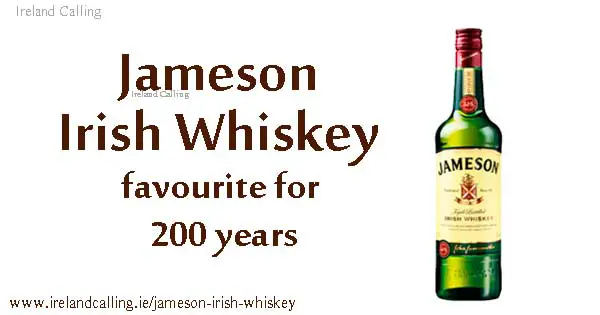Jameson Irish whiskey is one of the main alcoholic drinks exported from Ireland. There are more than 56million bottles produced each year at the Jameson distillery in Cork. It is by far the most popular Irish whiskey around the world.

According to the official Jameson website, only three main ingredients are used to make Jameson Irish Whiskey; barley, maize and pure Irish water.
Although Jameson is a famous Irish drink, it was first created by a Scotsman named John Jameson. He purchased the Bow Street distillery in Dublin in 1780 and began producing whiskey. Within 20 years, Jameson had increased productivity at the factory from 30,000 gallons a year, to one million gallons a year. Jameson Irish Whiskey had grown to become the world’s second favourite spirit, second only to rum. Jameson enjoyed its position as the market leader in whiskey exports for the best part of a hundred years.
‘Total Abstinence Pledge’ swept across Ireland
There were obstacles throughout the 19th century for Jameson to overcome. Firstly, there was a temperance movement that swept across Ireland in the 1830s, led by Catholic priest Theobald Matthew. Father Matthew was incredibly persuasive, and managed to get more than three million people across Ireland to take his ‘Total Abstinence Pledge’, and vow not to consume alcohol ever again – that was more than half the adult population in Ireland. Father Matthew also travelled to England and achieved similar results in Manchester, Liverpool and London. This sweeping movement severely decreased the alcohol market in Ireland and Britain.
The second problem Jameson faced at this time, was that their rivals in Scotland were starting to produce Scottish Whisky with column stills, while in Ireland pot stills were still being used.
This gave the Scottish companies a real advantage, as they were capable of producing whisky more quickly and efficiently than their Irish counterparts.

War of Independence blocked Commonwealth trade
 Jameson lost their position as the world’s number one whiskey exporter at the start of the 20th century, when two more events significantly damaged their trade links.
Jameson lost their position as the world’s number one whiskey exporter at the start of the 20th century, when two more events significantly damaged their trade links.
The Irish War of Independence took place from 1919 to 1921. The Irish Republican Army were waging war on the British troops stationed in Ireland. Michael Collins was the mastermind behind the Irish attacks. The British government reacted angrily to the Irish resistance. They placed a trade embargo on Irish products, meaning Jameson Whiskey couldn’t be exported to any of the Commonwealth countries.
At the same time, the US Government introduced prohibition, making alcohol consumption illegal.
In the space of a year, Jameson had lost access to its two biggest markets, the USA and the Commonwealth countries.
The Scotch Whisky companies took full advantage of this vacuum and established themselves as market leaders in Britain and also in Commonwealth members Canada and Australia.
Jameson took the financial hit and recovered after the both the trade embargo and the US prohibition were lifted.
In 1966, Jameson merged with Cork Distillers and John Powers to form the Irish Distillers Group. A new distillery was built, which now produces most of the Irish whiskey sold in Ireland. The Old Jameson Distillery in Dublin has been made into a museum.
Various cocktails include Jameson
Irish Distillers Group was taken over by French company Pernod Ricard in 1988, the same company that owns other familiar global drinks brands such as Tia Maria, Beefeater’s Gin and Jacob’s Creek wine.
There are several popular ways to drink Jameson. Many prefer it neat, either with or without ice. Others prefer to enjoy Jameson with a mixer. Jameson Ginger and Lime is a mix of Jameson, Ginger Beer and a wedge of lime. A Jameson Whiskey Sour is made by mixing one bar spoon of granulated sugar, 4 dashes of freshly squeezed lemon juice, a dash of sparkling water and 60ml of Jameson Irish Whiskey.
Other drinks such as the Irish Cocktail and the Tipperary are made using Jameson.
drinks.html